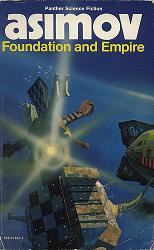
Second Foundation
Isaac Asimov
187 pages
published in 1953
Second Foundation is the third and last novel in the Foundation series, which popularised the notion of a Galaxy spanning empire in space opera. Originally published in 1951-53 and based on short stories from the forties, the series is now almost sixty years old, something to keep in mind when reading it. The series was revolutionary when it was first published, popularising not only the Galaxy spanning human empire, but also all the bagage associated with it. Asimov famously took Edward Gibbons’ Decline and Fall of the Roman Empire and transplanted it amongst the stars, with the background assumption that only an galactic empire could guarantee peace, yet it’s inevitable that it will decline into decadence and ultimately fall into barbarism. This became a staple of fifties and sixties space opera, with lesser writers uncritically using this for their own stories of galactic derring-do. It’s a very old fashioned concept now and its familiarity lesses the impact of the Foundation series.
The same goes for psychohistory, Asimov’s other great invention in the series, the use of mass psychology to predict the future actions of a large enough group of humans, with “large enough” being an entire Galaxy worth. What with quantum mechanics and the uncertainty principle and chaos theory and all the other half remembered scientific factoids we’ve all absorbed over the past six decades or so, the idea that a group of scholars could predict human history now sounds absurd. And yet… As Donald Kingsbury showed with his 2001 novel Psychohistorical Crisis — which you could call Foundation fanfic — that these ideas in themselves are still valid, can even now be used to create an interesting story. The question therefore is, if approached with an open mind, is the original foundation series still owrht reading in its own right and not just as a historical artifact?

